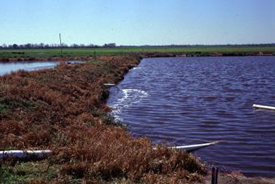AgEBB-MU CAFNR Extension
Using Maps For Manure Storage Management
The following table lists the five design storm criteria used to generate the estimated precipitation depth maps. The description of applicability to certain designs and/or situations in the table below relates to uncovered manure storage structures.
| Design Storm | Precipitation Description | Management Applicability |
|---|---|---|
| 25-year/24-hour period | Design Storm Safety Volume | Permit Implications |
| 10-year/10-day period | Chronic Storm Volume | Permit Implications |
| 10-year/90-day period | Storage Period Impact | Reduces Storage Period |
| 10-year/180-day period | Storage Period Impact | Reduces Storage Period |
| 10-year/365-day period | Storage Period Impact | Reduces Storage Period |
General Applicability
The importance of the different design storms for a given uncovered manure storage structure depends upon how full the structure is now, when the storage was last emptied and how long the design storage period is in days.
The 25-year/24-hour design storm is defined by regulation (MO 10CSR20-6.300) as a catastrophic storm event. The National Pollution Discharge Elimination System (NPDES) permit conditions does provide permit provisions for a storage structure to overflow without a violation only if a catastrophic storm occurs in the county where the structure is located and good management practices were implemented prior to the catastrophic storm event.
Chronic weather events defined by regulation (MO 10CSR20-6.300) include the 10-year/10-day; 10-year/90-day; 10-year/180 day; and 10-year/365-day periods. When chronic wet weather is occurring, land application and dewatering practices for wastewater storage structures are often delayed. When these wet periods occur, operations with uncovered manure storage structures need to monitor their storage levels and take action when conditions allow for land application.
Operations with the MO State No-Discharge CAFO General Permit are not permitted to overflow due to any circumstances. These operations with uncovered manure storages and using a no-discharge permit need to be extra aware of storage levels during chronic wet weather periods.
Using Design Storm Maps
The value of the maps serves two main purposes. First, the 25-year/24-hour storm map has value when a structure is full or close to full and a significant rainfall storm occurs. If a manure storage structure overflowed due to this major storm, one needs to know if this storm in fact exceeded the 25-year/24-hour design storm criterion. If criterion exceeded and the structure is permitted with an NPDES permit, this type of discharge is permissible as long as good management of storage can be documented. Second, the chronic storm maps (all but 25-year/24-hour) indicate areas where above average rainfall has occurred over an extended period of time.
Uncovered manure storage structures are designed using average rainfall and evaporation data. When an uncovered manure storage is located where chronic rainfall periods are occurring, this storage structure will be collecting more liquid than was designed to collect. This increased liquid volume is due to not only to increased precipitation as indicated by the maps but also from decreased evaporation because evaporation tends to be lower during periods of increased rainfall. Collecting liquid at a more rapid rate than was used during the design process will result in a shortened storage period. A shortened storage period means a structure will be full sooner than planned.

The 10-year/10-day design storm may have an impact on storage period but it typically really adversely impacts land application activities. When a 10-year/10-day storm occurs during a scheduled land application window, land application activities will likely be reduced. The reduced ability to land apply from storage can have a variety of impacts. The volume spread may have been reduced resulting in a shorter storage period after spreading. In a worst case scenario, no volume was spread in the planned application window resulting in a full storage and no planned spreading window remaining. This kind of scenario (can’t spread due to rainfall in planned spreading window) is why contingency plans should be developed and included in a nutrient management plan. The plan should identify land areas that can be used for land application when rainfall impacts either spreading window time periods or liquid volume to be spread.
The long term design storms (10-year/90-day; 10-year/180-day; and 10-year/365-day) will indicate for how long of a time period increased rainfall has been occurring. When these long rainfall periods are occurring where an uncovered manure storage is located, more precipitation based volume has been and is being collected than the volume used during design. The impact of how long the actual storage period will be reduced compared to the design storage period will vary depending upon the design storage period; the date storage was empty; and the storm duration occurring. Generally, the longer the available storage period and the shorter the storm period, the less impact is expected due to chronic rainfall. For example, a 10-year/90-day storm period that occurs early in a 365 day storage period may have little or no impact on the total 365 day storage period especially if a dry period follows the wet period. However, this same 10-year/90-day storm period that occurs early in a 180 day storage period will likely reduce the available storage period resulting in the storage being full before the date it is expected to be full. Finally, a chronic storm duration period that is a larger portion of the total design or planned storage period, the greater the impact on a reduced available storage period.
